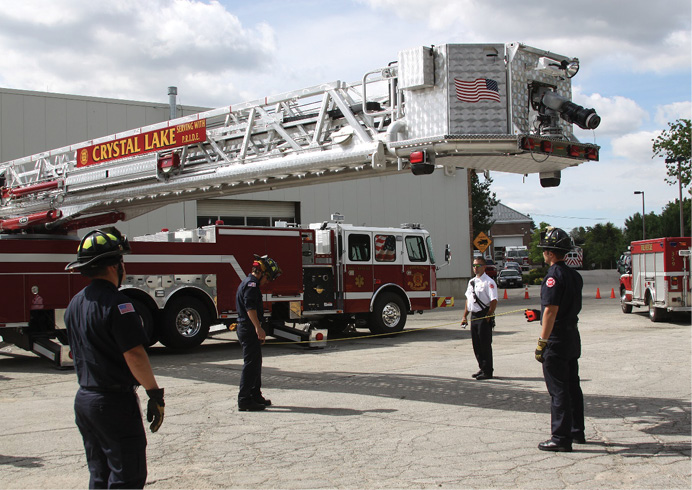
By Michael Wilbur
Many new models and configurations of aerial ladders have been introduced in recent years. For many years, there was a giant disconnect between the manufacturing sector and the end users of aerial apparatus. It has been my experience that many apparatus manufacturers do not understand how we use aerial devices on the fireground. In addition, many fire departments have very limited experience using their aerial apparatus, particularly with the decreasing frequency of building fires and the increasing emphasis on emergency medical services (EMS).
It is no secret that many fire departments have become EMS departments that occasionally respond to a fire. The kitchen table conversation rarely centers on the most recent working fire because no one can remember when it occurred. Instead, the morning table talk is likely to focus on the seven EMS runs that occurred between midnight and the shift change.
There has also been a tremendous turnover of experienced personnel in the fire service. Many of the veteran aerial apparatus operators who had extensive operational experience have retired and have taken that experience and knowledge with them. This has left an experience void not only with aerial apparatus but also across the entire firefighting spectrum.
ALSO
Using Aerial Ladder Tip Lights to Maximum Advantage
Safe and Effective Aerial Ladder Operations
WHEN SHOULD YOU PURCHASE AN AERIAL LADDER?
Knowledge is power, so the more you know about what you are trying to do, the better and safer the operation will be. Let’s start with some definitions and the basics.
Types of Aerial Apparatus
Aerial ladder. An aerial ladder in North America is available in lengths ranging from 55 to 137 feet. These apparatus are constructed of steel or aluminum and range from three to five sections (photo 1).
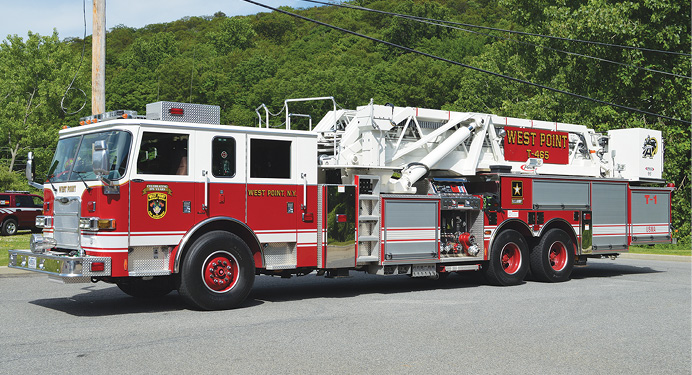
(1) An aerial ladder. (Photos by author unless otherwise noted.)
Tower ladder. A tower ladder incorporates a telescoping rectangular boom that supports a basket or platform. An escape ladder, which is not intended to be used for normal climbing or descent, is mounted on top of the telescoping boom. Tower ladders range between 75 and 110 feet in vertical reach and incorporate three to five telescoping sections. All the tower ladders currently available are mid-mount configurations (photo 2).
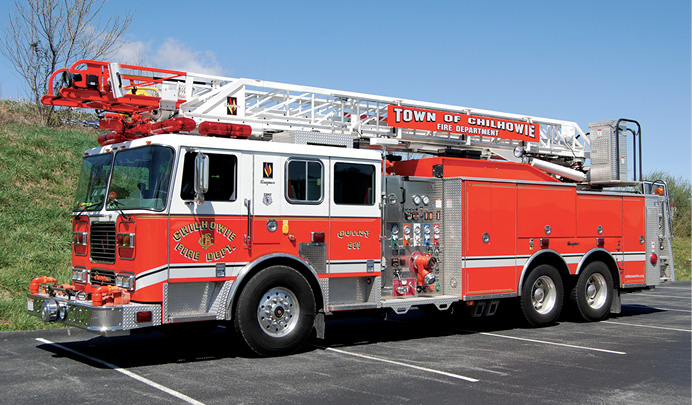
(2) A tower ladder.
Aerial tower. An aerial tower is an aerial ladder assembly that supports a platform. The aerial ladder can be used for normal climbing and descending; it provides an escape path from the basket.
Mid–mount aerial tower. Mid-mount aerial towers are generally constructed with four or five ladder sections. They range in vertical reach from 75 to 100 feet (photo 3).

(3) A mid-mount aerial tower.
Rear-mount aerial tower. The rear-mount aerial tower is generally constructed with three or four ladder sections and ranges in vertical reach from 85 to 110 feet (photo 4).
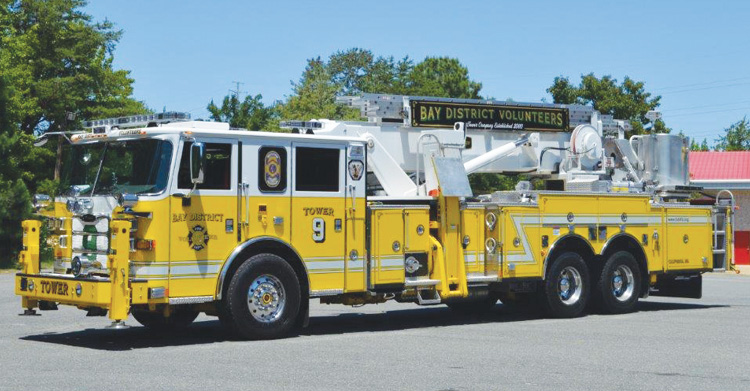
(4) A rear-mount aerial tower.
What Is a Quint?
It has been my classroom experience that many firefighters talk about quints and may even operate a quint or want to buy one, but they are often unable to define the term or explain why an apparatus is described as a quint.
A quint is a fire apparatus that incorporates five primary components: a pump, a water tank, hose, portable ladders, and an aerial device.
Scrub Area
The scrub area is the vertical surface area of a building wall that can be touched with the platform of an aerial tower or tower ladder or the tip of an aerial ladder. The scrub area is affected by the aerial apparatus design and configuration; the aerial apparatus positioning in relation to the building; and the aerial apparatus control, limits, and collision avoidance systems.
Aerial Apparatus Design and Scrub Area
It is not unusual today to spend more than a million dollars of taxpayer money for a new aerial device. Remember why you are buying an aerial apparatus: The aerial device defines the vehicle’s primary mission. Select the type of aerial device for the characteristics a needs analysis has shown are most important for the area in which it is intended to operate. Do you need an aerial ladder or an aerial platform? What are the heights of the buildings that must be covered? How much horizontal reach is needed? Are there areas with limited access and maneuverability for large apparatus? Are the typical buildings constructed very close to the streets, or do they have large setbacks? Are there low bridges in the community that limit travel height? Does the fire station have limitations that must be considered?
The scrub area is a key consideration when evaluating the types of aerial devices. In most cases, you want to be able to do more with an aerial device than reach the roof of a burning building or flow water. When the vehicle is properly positioned, how much building surface can be reached? This varies considerably according to the configuration of the apparatus and its position in relation to the building. The distance from the apparatus position to the building is often a major factor, particularly if the operating space is very limited.
Neglecting to give proper attention to the details of the apparatus configuration can reduce the aerial device’s scrub area. Ideally, you want to be able to raise, lower, and rotate the aerial device in any direction without limitations; but with many apparatus designs, different parts of the vehicle can get in the way, particularly when operating at low angles of elevation.
Raised-roof cabs can severely limit the scrub area toward the front of a vehicle, especially for mid-mount apparatus. If you have an apparatus cab with a 20-inch raised roof, you could lose the ability to reach the lower level of a building with the tip of the aerial device when operating over the front of the vehicle. The extra cab height costs more and then gets in the way when you need to work at a low angle.
High side compartments can also have a detrimental effect on the scrub area (photo 5). Can you rotate the aerial device when it is horizontal or slightly below horizontal without being blocked by the compartments? Are your low-angle options restricted to a narrow range directly off the sides of the vehicle? Keep the height of side compartments to a minimum so that you do not lose the lower-floor scrub area when working off the sides of the apparatus.
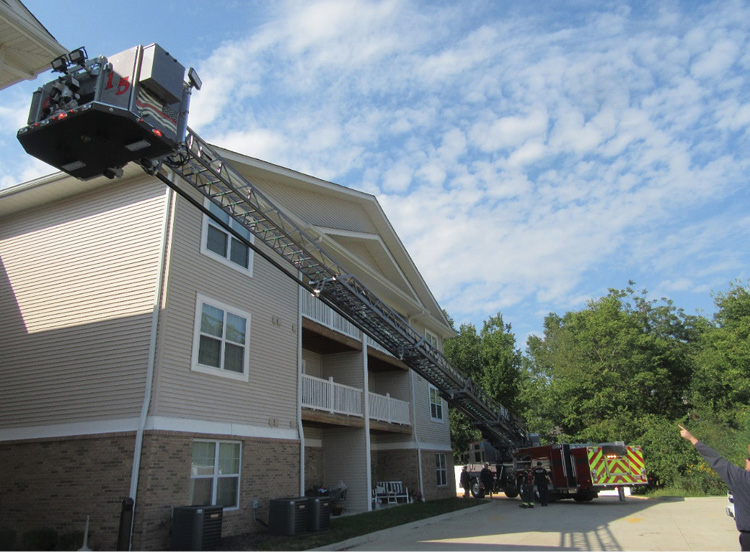
(5) Keep the height of side compartments to a minimum so that you do not lose the lower-floor scrub area when working off the sides of the apparatus.
Think about how much compartment space you need and how it can be configured. One of the upsides of buying a multifunctional vehicle is that it allows you to bring a lot of equipment to the fireground; the downside is that the completed vehicle may not do any one function especially well. If you need a rescue truck, maybe you should buy one instead of trying to load all of that extra equipment onto your aerial apparatus.
During the design phase, if the apparatus committee decides to mount cord reels, lights, saw boxes, and preconnected handlines on top of the compartments, that could create the same type of obstruction as an overly high compartment. The same problem can occur if the access ladders on the side of the truck are poorly positioned.
Aerial Apparatus Collision/Cab-Avoidance Systems
Collision-avoidance systems were developed to prevent apparatus operators from accidentally lowering or rotating the aerial device into the cab, compartments, or other mounted equipment on the top of compartments. An impact between a moving aerial device and a part of the vehicle can do significant damage. The new systems are programmed using a drawing that indicates all the obstructions that need to be avoided and their position in relation to the turntable. The system is then set to stop the aerial device a certain distance away from these danger areas to prevent a collision. This is a complicated process because the computer needs to recognize that the aerial device is moving toward a potential impact and slow its movement in time to stop gently before the impact can occur.
At the present time, there is no industry standard to define exactly how the systems are programmed. Some collision-avoidance systems are set up rather well and will stop the aerial device about six inches away from the potential impact point. In other cases, the system will prevent the aerial from coming within two feet of the obstruction. The excessive distance can needlessly restrict boom or ladder movements and reduce the scrub area dramatically.
In photo 6, the apparatus has a 20-inch raised-roof cab. The aerial was lowered until the collision-avoidance system stopped the movement and a measurement was taken from the bottom of the aerial tower ladder to the top of the cab. The distance was 26 inches. In this case, the apparatus would be hard pressed to ladder the fourth floor of a condo complex or to access the roof of a three-story garden apartment complex.

(6) This aerial ladder has a 20-inch raised-roof cab.
Fire apparatus manufacturers and most dealerships have a computer program for calibrating their collision-avoidance systems. A qualified technician can adjust the clearances between the aerial device and the obstructions.
What type of apparatus would have the best scrub area for the scenario in photo 7? Ideally, for a lower-floor fire such as a strip mall, the answer would be the aerial that will enable you to operate the aerial or platform basket as an offensive weapon from approximately −8° to +20° of elevation and to operate your prepiped ladder pipe or platform monitor into the first floor or directly into the cockloft to stop the spread of fire. You also want to be able to cover as much of the width of the building as possible.
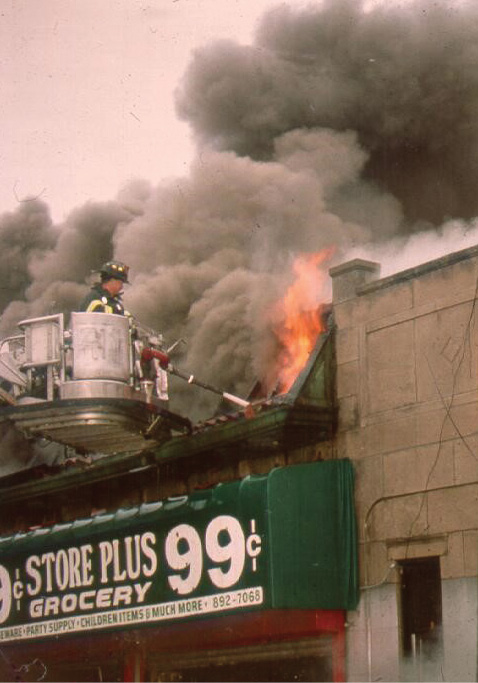
(7) For this fire, it would be ideal to be able to operate the aerial or platform basket as an offensive weapon from approximately −8° to +20° of elevation. (Photo by Matt Daly.)
Close-in Operating Capabilities
One of the most important considerations in positioning an aerial apparatus is the distance between the vehicle and the building. The ability to operate in tight spaces is directly related to the length of the ladder or boom when it is fully retracted. Photo 8 illustrates the distance from the platform to the vehicle with the device at a 90° angle to the chassis and 0° of elevation. These low-angle capabilities vary considerably based on the configuration of the vehicle, mid-mount or rear-mount; how much space is available to position the vehicle; and the distance between the apparatus and the building.
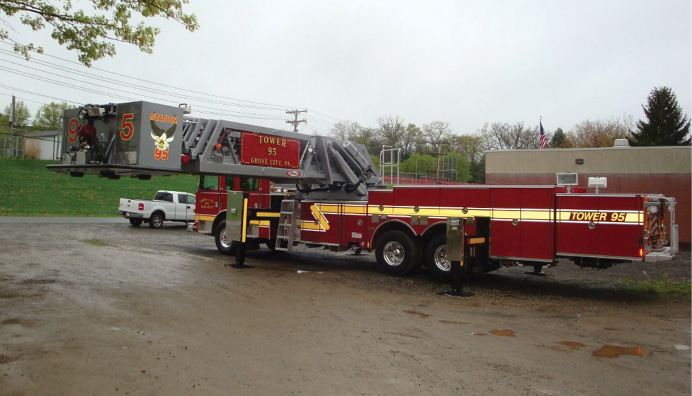
(8) Shown here is the distance from the platform to the vehicle with the device at a 90° angle to the chassis and 0° of elevation.
If the operating space is limited, you want to be able to rotate the ladder at a low angle when the apparatus is positioned close to the building. A mid-mount platform with a five-section ladder can operate in many more limited spaces than a rear-mount platform with a three-section ladder. Check the distance from the apparatus to the tip of the ladder or platform with the aerial horizontal and at 90° to either side. From this position, can you rotate the aerial at least 60° toward the front and rear of the vehicle without obstruction? These close-in capabilities increase your options when you have to position the apparatus close to the building and still maximize your reach in the scrub area.
Five-section mid-mount aerial towers are the best hands down. Three section rear-mount aerial towers are the worst. Four-section tower ladders and four- and five-section aerial ladders tend to fall somewhere in the middle (Table 1).
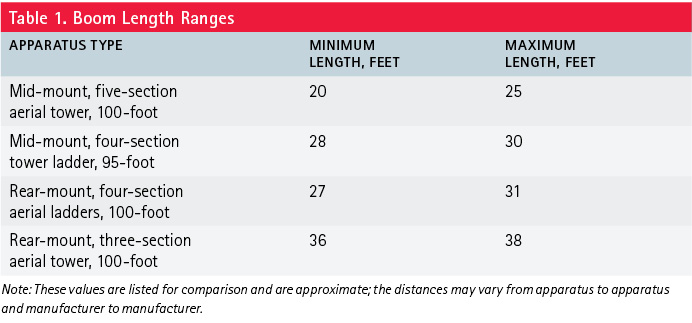
The next time someone asks, “What has a better scrub area, a mid-mount tower or a rear-mount tower?” you will have a factual answer—”the mid-mount.”
Aerial Apparatus Operational Footprint
Aerial apparatus operational footprint refers to the space needed to set up and operate your aerial apparatus at the scene of a fire. The starting point for this discussion is the length of the vehicle and the width with the jacks or stabilizers fully extended to either side, referred to as the “jack spread measurement.” This defines the space needed to set up the vehicle for unrestricted operations within a 360° circle (Table 2).

The footprint can be reduced in the short-jacked mode if the vehicle is designed to be operated in this manner. If the vehicle is short jacked, the outriggers are fully extended on the side facing the building where the aerial device will be operated. The jacks on the outboard side are not extended or are only partially extended before being lowered. An aerial apparatus equipped with underslung jacks generally cannot be short jacked.
The jack spread is essential to maintain the stability of the vehicle and prevent it from overturning. If the aerial device is going to be operated to only one side of the vehicle, the extension of the outboard jacks does not contribute to the stability of the vehicle. In that case, they are significant only if the master stream is being operated and creating a reaction force that pushes toward the opposite side. Most modern aerial devices have limit switches that prevent rotating to the side that is short jacked.
If the aerial device is equipped with envelope controls (an electronic system that controls aerial devices), it may be possible to operate with the jacks in different configurations; the envelope controls limit the operation and positioning of the aerial device to within the limitations of stability based on the positions of the jacks and the load applied to them.
The apparatus could be positioned in a very tight space so that one jack on the inboard side is fully extended between parked cars and the other is only partially extended while both of the outboard jacks are deployed straight down. The aerial device can still be operated to one side; however, the range of operation will be limited.
When considering the apparatus footprint, take into account the setback distance of buildings from the street or the area where the apparatus will be positioned. Will there be plenty of space for the vehicle and room without obstructions to swing the aerial device, or will it have to position on narrow streets with parked cars and lots of trees and power poles to get in the way? Are the buildings set far back from the street or do they come right up to the sidewalk? You not only need to have enough space for the vehicle, but it also needs to be in a location that allows you to operate effectively to do the job.
Example 1. A mid-mount aerial tower (five aerial sections) measures 22 feet, 4 inches from the side compartment of the apparatus to the farthermost point on the platform basket plus 8 feet, 2 inches for the chassis and 5 feet, 6 inches for the outboard, nonfire side, no working side jack. This provides a maximum footprint of 36 feet. With the outboard jack in the short-jacked position, the minimum footprint would be 30 feet, 6 inches. The footprint of a rear-mount aerial tower (three-aerial section) measures 38 feet, 2 inches from the side of the compartments on the aerial apparatus to the farthermost point on the platform basket. The aerial apparatus can occupy the most physical room on the fireground when the aerial device is at 0° of elevation and at a 90° angle to the chassis (photo 9).

(9) This photo shows the maximum amount of room that a tower ladder can occupy on the fireground without extending the device.
Example 2. If you lower the aerial device below 0° of elevation, the footprint will shrink. Using the same logic, if you raise the aerial device, the overall footprint will again shrink. The maximum footprint includes the measurement from the side of the body out to the farthest tip of the aerial device, the width of the chassis, and the outboard nonaerial device side of the truck jack or outrigger with which the truck is equipped (photo 10) plus 8 feet, 4 inches for the chassis and 5 feet, 10 inches for the outboard nonfire side jack equals a maximum footprint of 52 feet, 4 inches. The minimum footprint for a rear-mount three-section aerial tower would be 46 feet, 6 inches.
How many streets in your first-due area are more than 45 feet wide? The answer to the question would be, “Not many, if any at all.”
Much of this information is contained online in a Fire Engineering Training Minutes video (http://videos.fireengineering-training-minutes.com/detail/video/1380771835001/aerial-tower-vs.-tower-ladder).

(10) The firefighters are calculating the maximum footprint of this three-section, rear-mount aerial tower.
MICHAEL WILBUR has been a volunteer firefighter for more than 39 years and is a 31-year veteran of the Fire Department of New York (FDNY), from which he retired as a lieutenant from Ladder Company 27 in the Bronx. He is nationally recognized in the areas of emergency vehicle operations, apparatus placement, and apparatus purchasing.

